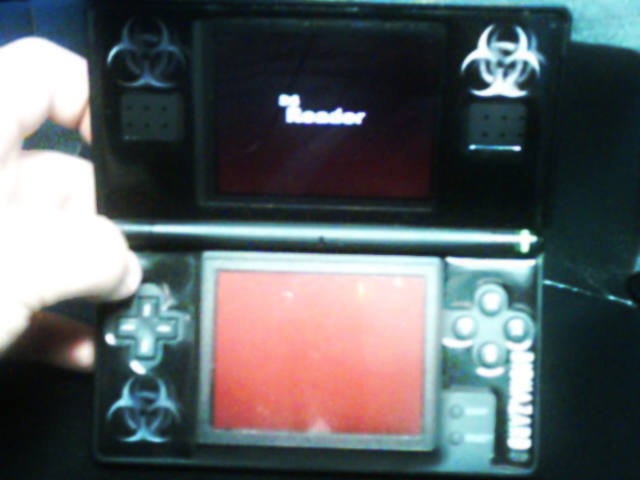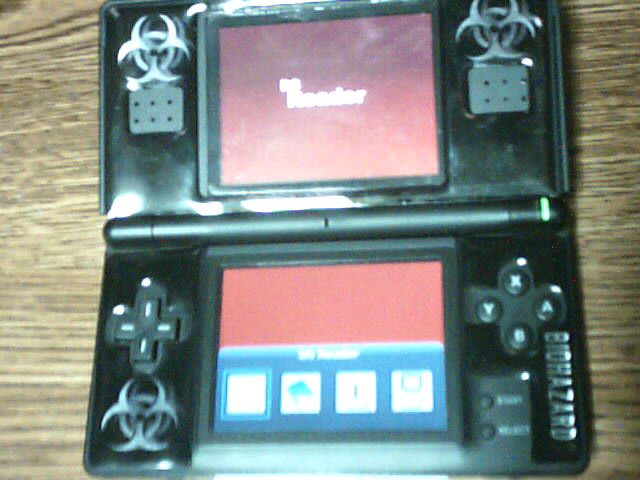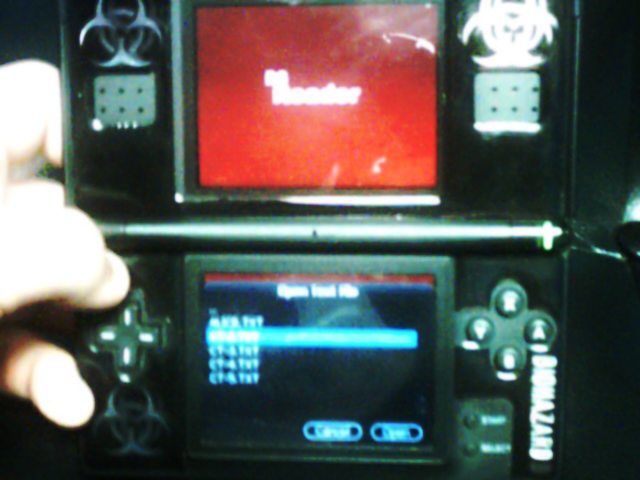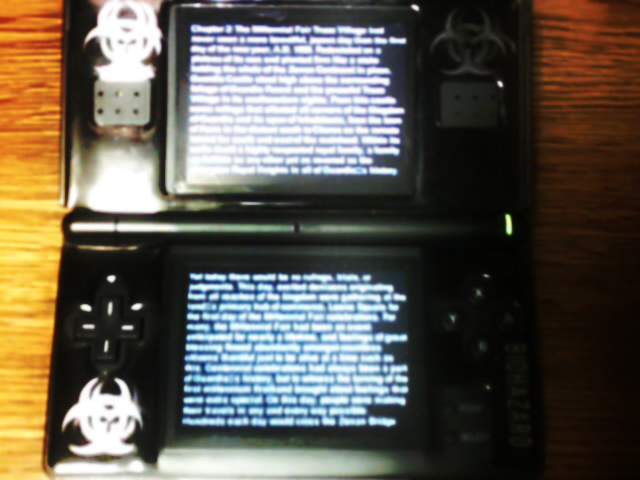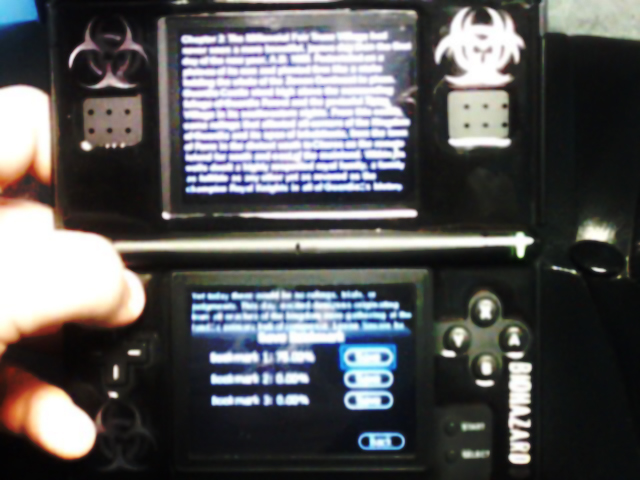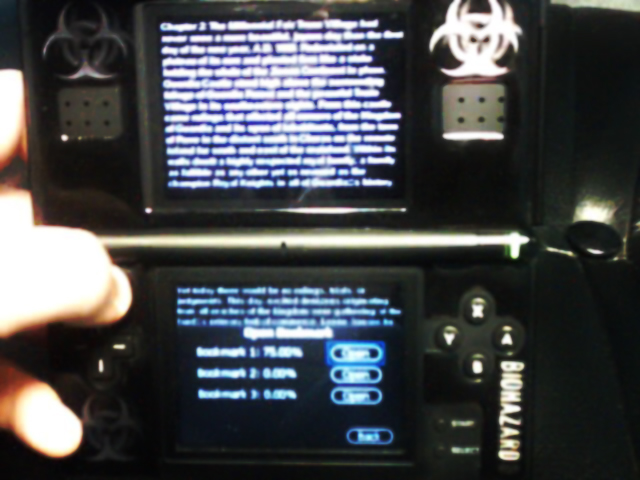Thanks to Trent for the amazing banner! | Hello there, and welcome to Skyline Reviews. I'm your host, Skyline770, also known as Skyline969 on GBAtemp. Here you'll find very in-depth reviews (both text and video) on various homebrew applications and games for the Nintendo DS. I hope you find everything enjoyable and informative. Without further ado, let's get straight to the reviews! An interesting side-note: I own an M3 Real running the latest version of M3 Sakura. If you are a fellow M3 Sakura user, you will have noticed by now that not all homebrew works. For that reason, I made a homebrew compatibility list over at GBAtemp, viewable by clicking here. |
Video Review: DiagnoSe
Video Review: DSTwitter (Video by tinymonkeyt)
Added to Skyline Reviews on 6/15/09
Text Review: DSReader
Added to Skyline Reviews on 6/14/09
(I apologize in advance for the poor image quality. This webcam's not the best! I'll find a better camera for my next review. And thanks to my friend Bre for fixing some of the images up! You're the Photoshop queen. =D)
Introduction
DSReader is a homebrew application designed by Eddie Park. It allows the user to view text files on his/her DS, and also allows the user to bookmark, change font (via standard font files that you can add to your card), and change the background (white font on black background or black font on white background) to suit your tastes.
Usage
Upon booting DSReader, you're presented with the main screen.
But what gives? Where is everything? Well, a quick flick of the stylus upward on the bottom screen exposes the menu. You could also press A.
From here, you can open a text file, load from your library, change font settings, and change your display settings. Starting things off, you'll obviously want to open a text file first. Touching Open (the first icon on the left) brings up this menu:
Simply navigate through the menu and find your text file. When you find it, touch it and it'll open.
As you can see, it's very straightforward from here. To go to the next page, press right or R. To go back a page, press left or L. (Please note, the []s are from my improper conversion of .pdf to .txt, and not a glitch in DSReader. They're supposed to be apostrophes.)
Now perhaps one of my favorite features of DSReader is the bookmark option. Once a text file is open, open the menu (slide the stylus upward or press A) and touch the second option on the left. To bookmark, touch Save Bookmark and choose a slot. Your place will be saved.
To load a bookmark, touch Open Library, locate your text file, and tap which bookmark you want to load.
Voila! You're back to your original spot.
That's pretty much it for DSReader.
Conclusion
I think DSReader is a solid app. It does its job extremely well, and I haven't seen another ebook reader out there for the DS that looks better.
Functionality: 10/10
Appearance: 8/10
Usefulness: 8/10
Stability: 10/10
Final Grade (not an average): 9/10
DSReader is a must-have for the avid ebook reader on the go. You won't be disappointed.
Text Review: M3 Sakura (As seen on GBAtemp)
The
M3 Team is well known for its reliable flashcards. The M3 Real is
definitely one of the best flashcards out there, and what makes it so
great would definitely have to be M3 Sakura, the newest firmware. It's
a massive step up from TouchPod, the old, slow, clunky firmware every
M3 Real owner cried themselves to sleep over. Those days of TouchPod
are (virtually) gone, however, and M3 Real owners can brandish their
beautiful cards everywhere knowing they finally have something to be
proud of.
Ok,
so you downloaded the firmware. All you do is delete the old SYSTEM
folder on your card and copy the new one over. That's it. If you're an
old iSakuReal user like myself, then you have to also delete iTouch,
defaultx.nds, and defaulty.nds. Trust me, you're not going to miss
them. Once you have the new SYSTEM folder on your card, stick it back
into your DS and power it on.

Tada!
You now have a firmware selection menu. Just choose Sakura; it's the
reason why you got this new firmware in the first place. Once Sakura
loads, you'll get a screen like this:

Just
choose the options you want and click Ok at the bottom of the menu.
Once you have done that, you are immediately taken to the file browser.
If this is your first time seeing Sakura, I will pause and give you a
minute to salivate over the sexiness of the firmware. Done? Ok, moving
on.
All
of your files and folders are visible right off the bat. If there are
some folders/files you don't want seen in Sakura, however, it's easy to
hide them. When you stick your SD Micro card into your computer, just
set the files you don't want seen as Hidden. What you can't see, Sakura
can't see, so it makes organization a breeze. However, your homebrew
apps will still see the folders and Sakura will still boot up normally.
Keep in mind they're hidden, not gone. Anyways, the entire interface is
touch-controlled, although you can use the buttons. For this review, I
will be demonstrating the use of the stylus. To move around, slide the
stylus up and down on the touch screen. To open a folder, slide it to
either the left or the right. Yes, lefties, Sakura also caters to your
horrible deformity. (That's a joke! I kid left-handed people!)

When
you open your music folder, you'll notice the icons are different for
music files. To start a music file, simply slide it to the right. The
audio playback is fairly impressive if I do say so myself. To open the
media controls, slide any music file to the left. The music controls
will open for a brief moment, then disappear. To get the controls to
stay put, tap Auto which will change to Lock. From there, you can skip
tracks, pause/resume playback, and change the play mode (random,
repeat, repeat all). With music, Sakura also has resume play. If you
shut off the DS in the middle of a song, it will pick up where you left
off when you turn the DS back on.

Yes,
you can also view images right in Sakura. Simply slide one to the right
or left. On the top screen is a fully zoomed-out version of the image.
On the bottom screen is a zoomed-in view of the image where you can
slide the stylus around to view it. Note the arrow buttons at the top
corners of the image on the bottom screen – you can tap those to go to
other images. The other icon at the bottom-left of the screen changes
the zoom of the image to 50%, 100%, or 200%. To set an image as your
wallpaper, change the zoom to 100% and press start. The image will then
load and become your wallpaper. If you don't like the "transparency"
Sakura sets, press select to go to the options menu. From there,
disable transparency for the top and bottom screen at the bottom of the
menu. Hit OK and let the image load again. Press start and re-apply the
image. To exit the image viewer, press B.

If
you used Sakura 1.12+a or earlier, you know how easy it is to skin in
Sakura. All of the skins from previous Sakura versions are compatible
with the newest Sakura, so feel free to use them. To use a skin, simply
locate the skin file in the file browser and slide it to the right or
to the left. The skin will be immediately applied. The skin I used for
this review is called VistaStyle.



Sakura
can also play videos too. The only formats I tested are .DPG and .DSM.
With the new Sakura DSM Video Encoder, you can also add a thumbnail
that shows on the top screen when you highlight a video. It's a nice
little thing to have. To play a video, slide it to the right or the
left. The video will play automatically. One thing you will notice off
the bat is the sexy player controls. They're pretty straightforward –
play/pause, skip buttons, play mode, stop, and a volume meter. Don't
adjust the volume over 100% or you may get distorted audio. Also on the
bottom screen is a brightness adjust button – tap it to change the
brightness. If you tap the white rectangle on the bottom screen, the
screen will fade. Simply tap the screen to make it visible again. To
exit the video, tap stop. Like music, the video player also has resume
play. If you shut off the DS while the video is playing, it will resume
where you left off when the DS is turned back on.


It's
simple to play ROMs in Sakura. Simply slide the one you want to the
right to start it and it will play automatically. If you want to enable
download play, cheats, real-time save, or other various goodies, slide
the ROM to the left. Alternatively, press X or Y while highlighting the
ROM. It will open the options menu for that ROM. From there, it's
pretty straightforward. You have your options to enable cheats with a
button combination or to turn them on all the time, an option to enable
soft reset or real-time save, and you can change the mode from standard
to download play or vice-versa. At least for me, I noticed that if you
turn on download play mode, Wi-Fi will not work normally for that ROM
until you disable download play. At the top, you also have buttons to
select the cheat file, select cheats, set up NDS and GBA linkage, and
to back up your RTS (real-time saves). If you place the cheat.db file
right in the SYSTEM folder, Sakura should find it without any problems.
In that case, just hit Select Cheats and choose your cheats, cheater.
When you're done messing around with the options, scroll down all the
way to the bottom and hit Ok. The game will then start. If you don't
want to keep your changes, hit Cancel and it will return to the file
browser.


Alas,
Sakura does have its downfall. One downfall. That, however, is a huge
one – mediocre homebrew compatibility. However, the homebrew
compatibility has skyrocketed from Sakura 1.12+a. In fact, you can check out how well homebrew works with Sakura here.
Some of the homebrew images may appear... mangled. This is normal and
it doesn't affect anything at all. To start a homebrew
app/game/emulator, slide it to the left or right. If it's compatible
with Sakura, it will boot and function normally. If it doesn't work
with Sakura, the firmware includes TouchPod which you can use to use
homebrew. TouchPod has outstanding homebrew support.
So,
you reeeeeally want to use that one homebrew app/game/emulator but it
doesn't work in Sakura, huh? Well, you can easily go to TouchPod on the
fly. While your DS is booting, hold A. Don't release A until the
firmware select screen appears. From here, select TouchPod. Keep in
mind that if you want to go back to Sakura, you must repeat this
procedure and select Sakura in the menu.
Sakura
is definitely a sexy firmware that can give all other flashcard users a
run for their money. Yes, even CycloDS users now have decent
competition.
Sleek GUI
Responsive controls
Built-in media players (pictures, music, and videos)
Excellent ROM compatibility (played every one I threw at it)
Simple skinning
Mediocre homebrew compatibility (but option to boot to TouchPod is a plus)
Download Play is reported to not work on a few games
Would
I recommend M3 Sakura? Definitely! M3 Reals are cheaper than CycloDSes,
so why not get one? In my opinion, M3 Sakura beats the CycloDS any day
at a reasonably less price. You just have to see it for yourself.
